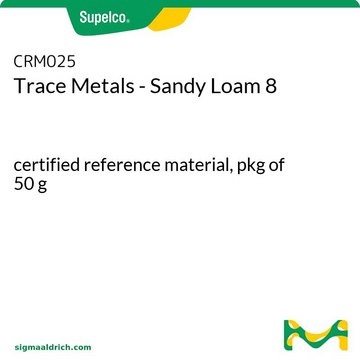CRM016
Trace Metals - Fresh Water Sediment 3
certified reference material, pkg of 50 g
Synonym(s):
Sediment matrix CRM, trace metals
Sign Into View Organizational & Contract Pricing
All Photos(1)
About This Item
UNSPSC Code:
41116107
NACRES:
NA.24
Recommended Products
grade
certified reference material
Quality Level
CofA
current certificate can be downloaded
packaging
pkg of 50 g
manufacturer/tradename
RTC CRM016-050
technique(s)
AAS: suitable
ICP: suitable
pH
7.85
application(s)
environmental
format
matrix material
storage temp.
2-30°C
General description
This Certified Reference Material (CRM) is produced and certified in accordance with ISO 17034 and ISO/IEC 17025. All information regarding the use of this CRM can be found on the certificate of analysis.
Application
- Bioremediation of AMD-polluted areas: The study examines the response of Propsilocerus akamusi to leachates from AMD-contaminated sediments using trace metal analysis, emphasizing the potential of metal bioremediation in aquatic environments, which is crucial for maintaining ecosystem health and supporting biotechnological applications in pharma and biotech industries (Zheng et al., 2024).
- Marine pollution control using dead seaweeds: Research on metal uptake by dead seaweeds provides insights into controlling marine pollution, highlighting the role of trace metal analysis in assessing environmental impacts and improving strategies for the pharma and biotech sectors (Vázquez-Arias et al., 2023).
- Mercury source tracing in coastal lakes: This study traces mercury sources and depositional history in northeastern U.S. lakes, utilizing trace metal analysis techniques, which are pivotal in environmental monitoring and have implications for public health and pharmaceutical research (Taylor et al., 2022).
- Metal bioaccumulation in urban river habitats: An assessment of metal bioaccumulation in freshwater gastropods from urban river habitats provides valuable data for environmental and pharmaceutical research, emphasizing the importance of trace metal analysis in studying biogeochemical cycling (Chukaeva and Petrov, 2023).
- Health hazards of elements in freshwater crayfish: The bioaccumulation and biosedimentation study of elements in crayfish from the River Nile addresses health hazards related to heavy metal contamination, serving as a critical reference for environmental safety and pharmacological studies (Abbas et al., 2023).
Other Notes
The following elements are not certified and are included for information only:
- Sb, B, Mo, Se, Si, Ag, Sr, Tl
Values of analytes vary lot to lot. Some lots may not contain all analytes.
Analyte
Description
Aluminum
Antimony
Arsenic
Barium
Beryllium
Boron
Cadmium
Calcium
Chromium
Cobalt
Copper
Iron
Lead
Magnesium
Manganese
Mercury
Molybdenum
Nickel
Potassium
Selenium
Silicon
Silver
Sodium
Strontium
Thallium
Vanadium
Zinc
See All (27)
Signal Word
Danger
Hazard Statements
Precautionary Statements
Hazard Classifications
Aquatic Acute 1 - Aquatic Chronic 2 - Carc. 1B - Eye Irrit. 2 - Skin Irrit. 2 - Skin Sens. 1
WGK
WGK 3
Choose from one of the most recent versions:
Certificates of Analysis (COA)
Lot/Batch Number
Don't see the Right Version?
If you require a particular version, you can look up a specific certificate by the Lot or Batch number.
Already Own This Product?
Find documentation for the products that you have recently purchased in the Document Library.
Customers Also Viewed
Our team of scientists has experience in all areas of research including Life Science, Material Science, Chemical Synthesis, Chromatography, Analytical and many others.
Contact Technical Service










